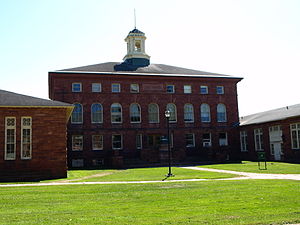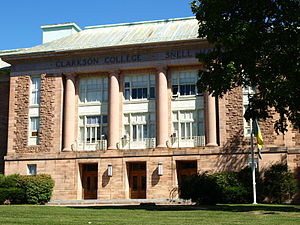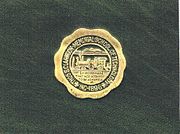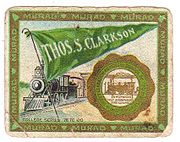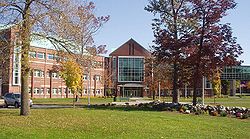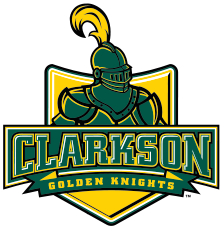- Clarkson University
-
Clarkson University 
Motto A Workman That Needeth Not to be Ashamed Established 1896 Type Private Endowment $128.3 million[1] President Anthony G. Collins Academic staff 182 Undergraduates 2,693 Postgraduates 39 0 Location Potsdam, New York, USA Campus Rural
640 wooded acres,
45 buildingsAthletics Division I Men's and Women's Hockey
19 varsity teamsColors Green and Gold Nickname Knights Mascot Golden Knight Website http://www.clarkson.edu Clarkson University is a private university located in rural Potsdam, New York. It was founded in 1896 and has an enrollment of about 3,000 students studying towards bachelor's, master's, and doctoral degrees in each of its schools or institutes: the Institute for A Sustainable Environment, the School of Arts & Sciences, the School of Business and the Wallace H. Coulter School of Engineering.
Contents
Programs
Clarkson University is home to the Center for Advanced Materials Processing (CAMP). CAMP at Clarkson University is dedicated to developing Clarkson's research and educational programs in high-technology materials processing. CAMP's mandate is to develop innovations in advanced materials processing and to transfer this technology to business and industry. The center receives support from the New York State Office of Science, Technology, and Academic Research for research and operating expenses as one of 14 Centers for Advanced Technology (CATs). In addition, CAMP-related work receives several million dollars each year from the federal government and private industry.
Clarkson's 16 Student Projects for Engineering Experience and Design (SPEED) teams allow students across all majors to participate in hands on, extracurricular projects.
Clarkson participates in student exchange programs with many schools in Europe and Australia. One example is the University of Leicester in the UK where students who are studying engineering come to Clarkson for a year as part of one of the exchange programs.
U.S. News & World Report's 2011 annual America's Best Colleges placed Clarkson University in tier one, the top tier of national universities, with a ranking of 124, and #37 on the Great Schools, Great Prices, a list of 50 national universities ranked according to their quality to price ratio [2]
Clarkson is #20 on the Fifty Most Affordable with a Return on Investment list, Bloomberg Businessweek, 2011.[3]
Clarkson is among the nation’s most environmentally responsible colleges, Princeton Review’s Guide to 311 Green Colleges: 2011 [4]
U.S. News & World Report's Best Graduate Schools 2012 ranks Clarkson 38th overall in Environmental Engineering and 58th in Civil Engineering.
History
The school was founded in 1896, funded by the sisters of Thomas S. Clarkson, a local entrepreneur who was accidentally killed while working in his sandstone quarry not far from Potsdam. When a worker was in danger of being crushed by a loose pump, Clarkson pushed him out of the way risking his own life. Clarkson was crushed against a wall by the swinging pump, sunstaining severe internal injuries. He died five days later. The Clarkson family realized great wealth in the development of such quarries, and Potsdam sandstone was highly sought after by developers of townhouses in New York City and elsewhere. The family were important benefactors in the Potsdam area. The school was called the Thomas S. Clarkson Memorial School of Technology.
In 1913 the name was changed to Thomas S. Clarkson Memorial College of Technology, which was used in a shortened version as Clarkson College of Technology or CCT. During the first half of the 20th century the majority of the campus was located "downtown". The campus slowly expanded to an area known as the "Hill", located on the south-western edge of the village. As of 2001, almost all academics and housing had moved to the hill campus, although the university still uses the downtown buildings known as Old Snell, and Old Main for administrative functions.
On 24 February 1984 the school officially became Clarkson University, although the pep band's rallying cry at hockey games is still "Let's Go Tech!". The school and its hockey team have carried the nickname "Tech" since the 1896 founding. "CCT" is still printed on older school property and equipment.
Much to the dismay of many alumni, the State University of New York at Canton (SUNY Canton) in neighboring Canton has informally adopted the moniker Canton College of Technology.
Historical Images [[File:|center|border|180x180px|alt=100px|Clarkson Memorial Hall]] Clarkson Memorial HallClarkson Memorial School of Technology Seal1914 Clarkson Murad CardThe Clarkson School
The Clarkson School, a special division of Clarkson University, was founded in 1978 as a unique educational opportunity. The School offers students an early entrance opportunity into college, replacing the typical senior year of high school with a year of college. It is one of few college early admission programs in the country that provides a real community living/learning experience on a university campus.
The Clarkson School's Bridging Year is a "bridging year" between high school and college for students who are ready to enter college early. Every year 50 to 80 11th grade students are accepted to The Clarkson School, where they work towards a GED and take college classes. They may also work with their high schools to complete a high school diploma. After they complete the program, they are given the option to enter Clarkson University with all credits from the previous year.
Students in The Clarkson School are fully matriculated undergraduates with freshman status at the University. They take classes with other University students and usually carry a course load of 15 to 18 credits per semester for two semesters. College credits may also be given for college and Advanced Placement courses taken before entering The Clarkson School. Cross-registration at neighboring area colleges and universities can provide additional college credits, particularly in art, music and languages. These credits also appear on an official Clarkson University transcript.
The Clarkson School students are housed in Newell House in Price Hall and the typical class size is about 50 students. Students participating in this program are called "Schoolies" by other Clarkson students.
Campus
Clarkson has two distinct campuses, the "downtown" campus and the "hill" campus. During the last 20 years Clarkson has developed almost exclusively on the hill campus. The Department of Physical Therapy is located in the downtown campus. The campus bookstore is located in the downtown Potsdam. The last student dormitory (Congdon) located on the downtown campus closed in May 2006. The only buildings remaining in Clarkson's service at the downtown campus are a few administration buildings, the Army and Air Force ROTC houses, as well as the Pre-PT (Physical Therapy) program. Most other downtown campus buildings have been leased or sold.
PC Magazine and The Princeton Review ranked Clarkson among the top-20 wired colleges in the nation for 2007.[citation needed] "The Top Wired Colleges" honors colleges with the most comprehensive—in terms of size, scope and quality—computing and technology offerings.
The 2007 Princeton Review considers Clarkson to be one of "Best Northeastern Colleges".
Academic buildings
- Bertrand H. Snell Hall ("New Snell") - Contains classrooms and home to the School of Business and the School of Arts and Sciences, along with the offices of the Department of Humanities and Social Sciences, and the Communication and Media Department. Snell also contains Clarkson's Writing Center and the Eastman Kodak Center for Excellence in Communication. Snell is also the newest building on the hill campus, having opened in 2001.
- Cora and Bayard Clarkson Science Center - Contains classrooms, student and research labs. Home of Computer Science, Math, Physics, Chemistry and Biology Departments. On the first and second floors towards Snell is the Biotechnology Wing, opened in Fall 2005. The Science Center is connected to Snell Hall by the Petersen Passageway on the third floor.
- Technology Advancement Center ("the TAC") - Contains two conference rooms/classrooms and three study areas on the second floor. The first floor is home to the Division of Research, laboratories and graduate student offices. The building also connects the Science Center and the ERC.
- Center for Advanced Materials Processing (CAMP) - Contains classrooms, student and research labs, and a machine shop. Home of Wallace H. Coulter School of Engineering.
- Rowley Labs - Connected to CAMP. Contains few classrooms and student labs. This building is used mainly for research.
- Educational Resources Center (ERC) - Contains Clarkson's library, the Career Center, and a common area for individual and group studying. Also contains a few classrooms.
Residential buildings
- Townhouses - Each Townhouse is a four person apartment with two double rooms and a bathroom upstairs. A kitchen and living room on the first floor. The Townhouses are generally used for theme and senior housing.
- Riverside - Each Riverside apartment contains a first floor with kitchen and living room. The upstairs varies and will house three to four people. A single and a double bedroom or two doubles. The Riverside apartments are generally used by theme housing and seniors.
- Woodstock - Woodstock apartments are for two to four people with three different configurations. The four person style has a living room, kitchen and two double bedrooms. There are two different two person styles, regular and efficiency. The regular two person apartments have a living room, kitchen and one double bedroom while the efficiency has just a kitchen and living room which doubles as a bedroom as well. Woodstock housing is used by seniors and a few juniors.
- New Dorms - The New Dorms consist of the Price and Graham complexes, each split into four Houses. The Graham Hall complex consists of Donahue, Olson, Van Note, and Wilson Houses, while the Price Hall complex consists of Farrisee, Newell, Ormsby, and Thomas Houses. Newell House is reserved for the Clarkson School, the others are used by honors students, Clarkson School mentors, and others. There are a few styles of rooms. Most are four person suites containing 2 double bedrooms linked by a common bathroom. The other four person suites are composed of a single double bedroom and two single bedrooms which share a single bathroom. There are a handful of single double bedrooms, which have their own bathroom. These few double bedrooms are much larger than any other suite. In the center core of the Graham complex is the Graham Cafeteria (currently not in operation), and in the center core of the Price complex are the Student Support Services offices, First-Year Advising offices, and Clarkson School/Honors offices.
- Moore House - Generally inhabited by juniors and sophomores, it is the closest residential building to Snell Hall and the Science Center. It contains four person suites consisting of two double bedrooms joined by a common bathroom. The first floor of Moore is home to the Clarkson University CEO Program. Construction is currently being done to enlarge more house and provide more residential area.
- The Quad - Used for freshman housing. The Quad is composed of four buildings- Ross, Brooks, Cubley, and Reynolds Houses - linked by the Ross-Brooks eatery, between Ross house and Brooks house, and Empire Diner, between Reynolds house and Cubley house. The laundry is located between the fours houses. Although all the building are connected, it is impossible to move between all four houses without going outside. Due to the fact that Empire Diner was put between Reynolds and Cubley and you have to enter Empire from the middle building. It is however possible to move between Ross and Brooks without going outside. The Quad buildings are four stories high. With the fourth floor rooms being bigger than the rest of the floors, but usually containing triples instead of doubles.
- Hamlin-Powers ("The Pit") - The original hill campus student housing, consisting of Hamlin and Powers Houses, once highly sought for being the closest to the downtown campus and being right across the street from the old hockey arena, is now the lowest priority housing and home to many sophmores and few freshman. The buildings were renovated in 2003 and have the same layout as the buildings in the Quad. The Student Health Center which was located in between the two wings of the building has recently been moved to the ERC.
Other buildings
- The Student Center is a student centered building constructed between the Educational Resources Center and CAMP. The official groundbreaking was held on May 9, 2009, but construction did not begin until June 8, 2009. Its official opening was on August 27, 2010. Eateries include a cafeteria and a revamped Java City. Other amenities include the POD Market, mailroom, radio station, TV station, and newspaper office on the basement level; the Clarkson University Student Association (CUSA) offices on the second floor; and large amounts of lounge space on all three levels. The core of the building is home to a large presentation area known as the Forum, used for presentations and activities.
- Cheel Campus Center - Contains eating facilities, including a Subway, Club 99 (on campus bar), Residential Housing Administration, Dean of Clarkson University and, of course, Cheel Arena (home of Clarkson's hockey teams).
- Adirondack Lodge - A cabin of sorts, built behind the townhouses and tucked into the woods on the edge of campus. This building is used by all the outdoor clubs including the Outing Club, Ski Club, Cycling Club and Nordic Ski Team. Gear lockers are contained in the basement while the first floor is used as a meeting place for clubs and organizations. The upstairs floor is reserved living quarters for the head of Outdoor Recreation.
- Indoor Recreation Center (IRC) - Contains a field house with basketball courts and an indoor track, swimming pool, racquetball courts, exercise equipment, and a parquet floored gymnasium with bleachers. The Alumni Gymnasium is home to Clarkson's basketball and volleyball teams, and Fuller Pool is home to Clarkson's swim teams.
- Boat House - Located behind the Riverside apartments on the Raquette river. This building contains canoes and kayaks owned and maintained by the Outing Club.
Dining facilities
- Ross-Brooks Marketplace ("Ro-Bro") - Located in the Quad, Ro-Bro is an all-you-can-eat dining hall facility open seven days a week.
- Empire Diner ("Empire") - Also located in the Quad, Empire is a nostalgic dining facility with all-you-can-eat for lunch and dinner.
- Bené Pizzeria - Located inside Student Center, Bene Pizza sells pizza and pasta.
- Main Street Café - Located inside of the Cheel Campus Center, the Main Street Café food court contains : Subway.
- Student Center Dining Hall - Pasta Station, Salad Station, Pizza, Grill, Panini Station, and Asian Grill.
- Bar 9 - Located in Student Center with foosball, pool and dartboard.
- Java City - Located in the Student Center, Java City sells coffee, specialty beverages and pre-made sandwiches.
- Concrete Café - Located on the third floor of the Science Center, the Concrete Café sells coffee, soup, and sandwiches.[5]
Student activities
Athletics
Clarkson University's NCAA Division I Golden Knights compete in Men's and Women's ice hockey. The men's team was a number one seed in the East region of the 2007 NCAA Division I Hockey Tournament and is a traditional power in the ECACHL. Clarkson, as the number three seed in the 2008 NCAA East regional, knocked off St. Cloud State 2-1 to advance to the second round. The Golden Knights were then defeated by national number one seed, Michigan 2-0. Other Division III varsity teams compete in the Liberty League conference and include Men's Baseball, Basketball, Golf, Lacrosse, and Soccer, Women's Basketball, Lacrosse, Soccer, and Volleyball, as well as combined Men's and Women's Alpine Skiing, Cross Country, Nordic Skiing and Swimming.
Other non-varsity clubs include Men's and Women's ice hockey, Men's and Women's Rugby union, Men's Soccer, Men's Bowling, combined Men's and Women's Crew and Ultimate Frisbee. Clarkson's combined Men's and Women's club Racquetball Team won the Division II title at the USRA National Tournament in 2005. In 2010, the school started a club football team known as the Golden Knights. They will be entering into their second season in the Fall of 2011.
Clubs
Clarkson University's Student Association (CUSA) sponsors over 50 clubs, the largest of which being the Outing Club, Ski Club, The Clarkson Pep Band, Clarkson Theatre Company, and the Clarkson Union Board. All CUSA sponsored clubs are entirely student run and both undergrad and grad students are welcome to join any time.
In addition to these, Clarkson University's chapter of the Collegiate Entrepreneurs Organization has over 100 members, spanning every academic school, and has for the past number of years continued to win many awards at their National Conference; including Best Overall Chapter in 2005, and Best Business in 2005 and 2006. The club currently owns and operates four distinct businesses, including Knights Unlimited (The Kiosk) located in the Cheel Campus Center.
Electronics Society and Amateur Radio Club (K2CC), established in 1922 is the University's oldest organization that is still active today. The club offers two licensing exam sessions per semester and interacts regularly with the local community. K2CC has both analog and digital voice repeaters and maintains a contest and experimentation room equipped with DX, weak signal and satellite radios and antennas.
With WTSC 91.1 FM The Source, Clarkson also offers one of the North Country's most popular radio stations, which is run completely by the student body. Students can broadcast their own shows, and offers a wide variety of music from Rap to Alternative, from Classic rock to street punk. The station has well over 1000 CDs and nearly 24 Terabytes of music on vinyl. The station has a fully equipped broadcast studio (studio A), as well as a second studio for mixing (studio B), and a fully functional recording studio.
The Clarkson Photo Club is a group of students with strong interests in photography, ranging from black and white, color, or digital.
Clarkson Golden Knotes is the Co-ed a Cappella group on campus. Every semester a Final Performance is held to showcase the songs the group worked on for that semester. They also perform at various events on campus.
Clarkson FIRST Robotics is a unique club on campus that brings Clarkson University students together with local high school students to design, build, and test a robot that competes in the FIRST Robotics Competition each year.
Applied CS Labs - The Applied Computer Science Labs at Clarkson University consist of the Clarkson Open Source Institute, the Internet Teaching Lab, and the Virtual Reality Lab. These labs, which are part of the Computer Science department, are almost entirely student-run, offering the opportunity to gain experience in managing both facilities and projects. All three labs are located on the 3rd floor of the Science Center in rooms SC334 and SC336.
Clarkson Pep Band
The Clarkson University Pep Band is a student-run organization that supports the Clarkson University Golden Knights ice hockey teams. The band consists of approximately 75 full-time members, and performs at Clarkson's Cheel Arena at all of the home games for the Men's NCAA Division 1 hockey team and some games for the NCAA Division 1 Women's team.
The band also travels to Clarkson Men's ECAC Hockey conference away games with 35-40 members (unless restricted by the policies of the opposing team's arena) and post-season tournaments.
The Clarkson University Pep Band was founded in the fall of 1964, by a small group of Clarkson students. By the 1980s, the band's membership grew significantly.
The current conductor of the Pep Band is Nick Van Derzee.
Clarkson Theatre Company
The Clarkson Theatre Company (CTC) is a student-run theatre group, part of Clarkson University and supported by the Clarkson University Student Association (CUSA). The mission of CTC is to provide both theatrical entertainment and an outlet for artistic self-expression in the realm of the theatre arts at Clarkson. Membership consists of students and faculty from Clarkson and the other Associated Colleges of the St. Lawrence Valley (SUNY Potsdam, SUNY Canton, and St. Lawrence University)
Every fall, CTC puts on a musical over Clarkson University's family weekend, sometime in mid-to-late October. The production time for this show is between 5 and 7 weeks. After the fall production is over, preparations for the One Act Festival begin. This festival is made up of short plays chosen and directed by students, as well as several written by students as well. This festival is usually put on as a fundraiser for a charity chosen by the executive board, and takes place at the end of January or beginning of February. The next show, usually a straight play, is put on near the beginning of April. Show choice for each slot is not limited to either a musical or play, but it is traditional to use this structure; as shows are chosen by a general member vote, however, any show can be chosen to be put on any semester.
CTC's most famous alum is not a student, but an adviser. Wes Craven, creator of the A Nightmare on Elm Street franchise, was a professor at Clarkson University in 1968, as well as faculty adviser to the Clarkson Drama Club (the predecessor of the current Clarkson Theatre Company). As part of one of Professor Craven's classes, Humanities IV, several Theta Chi members wanted to make a spoof of traditional horror movies, about the strange occurrences in their fraternity's house at 18 Elm Street. The filming included CTC's home, Old Snell Hall, where the boiler room scene took place in the basement. While none of those involved had very much film experience, they made the film for about $300 and it was shown twice on campus.[6] Much of Craven's inspiration for A Nightmare on Elm Street came from this first filmmaking experience; the house in the movie, while not the house used in the first version, resembles this house and also resides on Elm Street. The town in A Nightmare on Elm Street is named Madstop, which is Potsdam backwards.
Fraternities and Sororities
Clarkson social fraternities began organizing on campus in 1904, and social sororities in 1977. A time line shows the interesting history many of the organizations have had. Over the years, there have been many different fraternities and sororities that have come and gone due to declining membership, university probationary periods, and disaffiliation from nationals . In order for the university to recognize a Greek organization, all the members must be registered Clarkson students. Additionally, any organization applying for recognition after 1977 must affiliate with a national organization within five years to maintain recognition. Clarkson recognized international and national fraternities are Delta Upsilon, Phi Kappa Sigma, Sigma Chi, Alpha Chi Rho, and Sigma Phi Epsilon; local fraternities are Lambda Phi Epsilon, Omicron Pi Omicron,and Zeta Nu. Clarkson recognized international and national sororities are Delta Zeta, Phi Sigma Sigma, and Theta Phi Alpha. Additionally, there are a number of professional Greek lettered organizations: Alpha Kappa Psi, Chi Epsilon, Omega Chi Epsilon, Phi Delta Epsilon, Phi Kappa Phi, Tau Beta Pi, and Tri-Beta.
Interfraternity Council
The Interfraternity Council (IFC) provides outlets for social interaction among the fraternity and sorority members. IFC helps to sponsor educational opportunities for all of its members and to help to promote the fraternal ideals of leadership, scholarship, service, community and brotherhood.
Panhellenic Council
The Panhellenic Council is the governing body of the sorority system. The Panhellenic Council provides many opportunities for involvement in campus life and the fraternity and sorority system outside of the individual sororities. Recruitment, social, and educational opportunities are provided by the council. All social sororities recognized by Clarkson University are active members of the National Panhellenic Conference.
Greek Life
A few organizations have chapter houses off campus; others have plans of having chapter houses on campus in the near future. Clarkson fraternities and sororities take great pride in their chapter houses because of the rich local history each residence has.
The Greek community is very tight knit because of the university's small size. Fraternities and sororities attend each others' national philanthropy and local community service events. Greek Week and Ice Carnival have an extensive history both with the college and local Potsdam community.
Publications and media
- The Integrator is a weekly student-run newspaper which is distributed on Clarkson's campus as well as the town of Potsdam.
- WCKN Television is a student-run television station and is also the local cable systems public access station. In-house programming includes hockey games, news, talk shows, comedy shows, game shows, and various other Clarkson sporting events.
- WTSC Clarkson Radio is a student-run radio station that gives students the opportunity to produce their own weekly radio programs, and consequently serve the community by offering entertainment, news and weather, and special programming via the radio.
- The Clarksonian is a student-run yearbook publication group.
ROTC
Clarkson University is a host university for both the Army ROTC and Air Force ROTC. ROTC has been an institution at Clarkson since May 1936, when the first ROTC Battalion was activated during the tenure of College President James S. Thomas. The ROTC program at Clarkson has commissioned well over 1,150 military officers. These alumni have been represented at each level of the Officer Corps, from Second Lieutenant to General.
Army ROTC
The Clarkson Army ROTC Battalion (officially the "Golden Knight Battalion") is one of 272 Army ROTC battalions in the United States. The average size of the Golden Knight Battalion is 100 Cadets, comprised majorily of Clarkson students. The headquarters for the Golden Knight Battalion is at 49 Elm St. on Clarkson's downtown campus, where it has been located for decades.
Notable alumni
- Kaitlin Monte (2011 Miss New York)
- Barney Adams (Founder of Adams Golf)
- Hugo Belanger (hockey player, Adirondack Hockey Hall of Fame)
- Bob Chiarelli (former mayor, Ottawa, Canada)
- Chris Clark (hockey player)
- Erik Cole (hockey player, Olympian, Stanley Cup champion)[7]
- Craig Conroy (hockey player, Olympian)[7]
- Grant Clitsome (Hockey Player, Columbus Blue Jackets)[7]
- Gregory C. Farrington (Former president of Lehigh University, Executive Director of The California Academy of Sciences)
- Harvey Glatt (founder of CHEZ-FM radio and notable Canadian music impresario)[8]
- Paul Horn (sr. vice president, R&D, IBM)
- Kent Huskins (hockey player, Stanley Cup champion)
- Roger Johnson (American businessman and government official)
- Randy Jones (hockey player)
- Georgia Keresty (president, JANSSEN Alzheimer Immunotherapy Research & Development, LLC)
- Craig Laughlin (hockey player, television color analyst for Washington Capitals games)
- Todd Marchant (hockey player, Olympian, Stanley Cup champion)
- Patrick Naughton (co-creator of Java programming language)[9]
- Russ Nelson (Open Source Initiative board member)[10]
- Willie Mitchell (hockey player)
- Colin Patterson (hockey player, Stanley Cup champion)
- Jack Phillips (Major League Baseball player, and a long-time Golden Knights coach)[11]
- Katherina Reiche (German politician)
- Martin Roesch (author of Snort and founder of Sourcefire)
- Dede Scozzafava (former congressional candidate and current New York State Assemblywoman)[12]
- Mike Smith (NHL hockey executive)
- Dave Taylor (hockey player, NHL hockey executive)
- Paul Tonko (Congressman for New York's 21st congressional district)
- M. Emmet Walsh (actor)[13]
- Shawn Weller (hockey player)[14]
- Todd White (hockey player)[7]
- Steven Zalewski (hockey player)
- Nick Dodge (hockey player)
- Mark P Kahler (Intellectual Property Attorney)
- Sharon Stevens Chadwick (Science Librarian , Humboldt State University)
See also
References
- ^ As of June 30, 2009. "U.S. and Canadian Institutions Listed by Fiscal Year 2009 Endowment Market Value and Percentage Change in Endowment Market Value from FY 2008 to FY 2009" (PDF). 2009 NACUBO-Commonfund Study of Endowments. National Association of College and University Business Officers. http://www.nacubo.org/Documents/research/2009_NCSE_Public_Tables_Endowment_Market_Values.pdf. Retrieved March 8, 2010.
- ^ Find the Best College for You
- ^ [1]
- ^ [2]
- ^ Clarkson University: On-campus Dining Locations
- ^ History of Potsdam's A Nightmare on Elm St. - Entertainment
- ^ a b c d "Awards, Activities, And Athletics At Clarkson Alumni Reunion July 10–13". 2003-06-27. http://www.clarkson.edu/news/view.php?id=852.
- ^ Billboard Magazine. 1974-09-07. http://books.google.com/books?id=RAkEAAAAMBAJ&lpg=PT69&ots=zRlB8Akgjx&dq=harvey%20glatt%20clarkson&pg=PT69#v=onepage&q=harvey%20glatt%20clarkson&f=false.
- ^ "Naughton: the American Dream Part IV". 2000-03-21. http://news.zdnet.co.uk/internet/0,1000000097,2077846,00.htm.
- ^ "Clarkson Alumnus Russell Nelson to Discuss Domain Name System". 2006-11-03. http://www.clarkson.edu/news/view.php?id=1602.
- ^ "Clarkson Legend JACK PHILLIPS Passes". 2009-08-31. http://www.clarksonathletics.com/news/2009/8/31/GEN_0831092237.aspx.
- ^ "Meet the 23rd Congressional District candidates: Dede Scozzafava". 2009-10-12. http://blog.syracuse.com/politicalnotebook/2009/10/meet_the_23rd_congressional_di_2.html.
- ^ "M. Emmet Walsh Of Culver City, Calif. And Swanton, Vermont, Receives Clarkson University's Highest Alumni Honor". 1998-08-21. http://www.clarkson.edu/news/view.php?id=1040.
- ^ "Know Your Knights: Weller And Willemsen". 2006-11-06. http://media.www.clarksonintegrator.com/media/storage/paper280/news/2006/11/06/Features/Know-Your.Knights.Weller.And.Willemsen-2442263.shtml.
External links
Coordinates: 44°39′49″N 74°59′57″W / 44.663495°N 74.999070°W
ECAC Hockey Men Brown Bears (Meehan Auditorium) • Clarkson Golden Knights (Cheel Arena) • Colgate Raiders (Starr Rink) • Cornell Big Red (Lynah Rink) • Dartmouth Big Green (Thompson Arena) • Harvard Crimson (Bright Hockey Center) • Princeton Tigers (Hobey Baker Memorial Rink) • Quinnipiac Bobcats (TD Bank Sports Center) • Rensselaer Engineers (Houston Field House) • St. Lawrence Saints (Appleton Arena) • Union Dutchmen (Achilles Rink) • Yale Bulldogs (Ingalls Rink)
Women Brown Bears (Meehan Auditorium) • Clarkson Golden Knights (Cheel Arena) • Colgate Raiders (Starr Rink) • Cornell Big Red (Lynah Rink) • Dartmouth Big Green (Thompson Arena) • Harvard Crimson (Bright Hockey Center) • Princeton Tigers (Hobey Baker Memorial Rink) • Quinnipiac Bobcats (TD Bank Sports Center) • Rensselaer Engineers (Houston Field House) • St. Lawrence Saints (Appleton Arena) • Union Dutchwomen (Achilles Rink) • Yale Bulldogs (Ingalls Rink)
Liberty League Full members Bard • Clarkson • Hobart • RPI • RIT • Rochester • St. Lawrence • Skidmore • Union • Vassar • William Smith
Associate members U.S. Merchant Marine (football) • Susquehanna (football) • WPI (football)
Former member Hamilton
Categories:- Universities and colleges in New York
- Middle States Association of Colleges and Schools
- Association of Independent Technological Universities
- Engineering universities and colleges in New York
- Educational institutions established in 1896
- National Association of Independent Colleges and Universities members
- Clarkson University
- Universities and colleges in St. Lawrence County, New York
Wikimedia Foundation. 2010.

